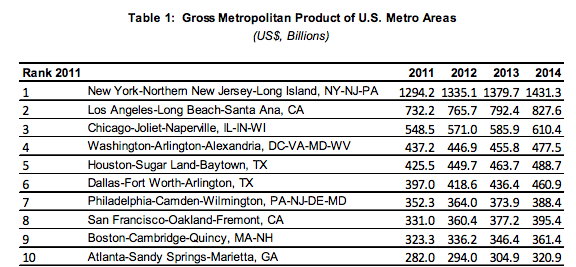We can talk all we want about the Metro Revolution and the increasing power that local policymakers wield, but many metropolitan areas still struggle as much as the rest of the country. According to a report released by the U.S. Conference of Mayors on Monday, the economies of 119 metro areas either dropped or floundered with the same output in 2012. The total gross metropolitan product (GMP), meanwhile, grew by 2.5 percent.
Despite the decline and stagnant growth, U.S. metro regions remain a curious juggernaut. “New York, Los Angeles and Chicago — the three largest — produce more annually than countries such as Sweden, Norway, Poland, Belgium, Argentina and Taiwan,” the report found. New York and L.A. each produce more than 46 states. Thirty-six of the 100 largest economies in the world are American metro areas.
Big business is still booming in Texas, where Midland’s economy grew the most, by 14.4 percent. Odessa (14.1 percent) and Victoria (8.7 percent) also snuck into the top 10. (Austin came in at 11 with a GMP spike of 6.5 percent.)
But the bulk of the nation’s production is concentrated in the top 10 metro areas, which you can see in the chart below. With a collective GMP of $5.34 trillion, they outpace the gross state product of the least-producing 36 states combined. And 92.3 percent of the jobs added last year came from the 363 U.S. metros. Numbers are obviously a part of this — there are more people in cities — but this still reinforces the argument that metro economies are the country’s greatest asset.

The Equity Factor is made possible with the support of the Surdna Foundation.

Bill Bradley is a writer and reporter living in Brooklyn. His work has appeared in Deadspin, GQ, and Vanity Fair, among others.

















